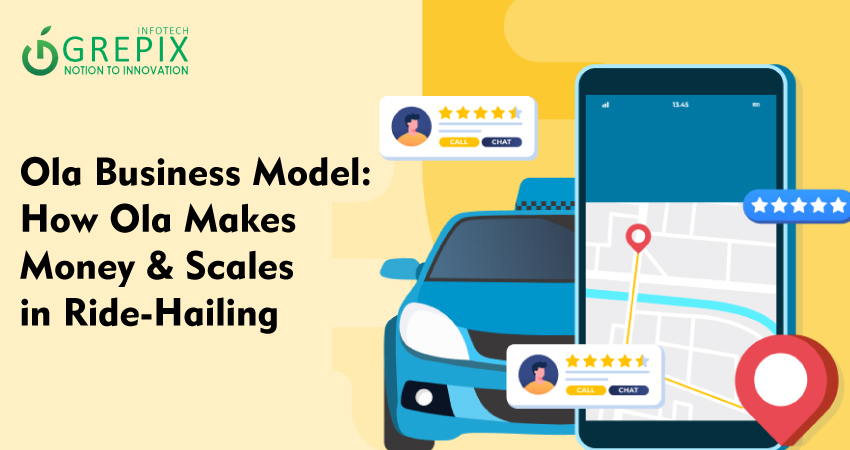Ola Business Model: How Ola Makes Money & Scales in Ride-Hailing
Ola has revolutionized how millions commute across Indian cities and beyond, leveraging powerful technology and a customer-focused platform the very foundation of successful mobility app business strategy. Founded in 2010, Ola’s platform spans 250+ cities with over 1.5 million driver-partners, serving more than 150 million active users worldwide. Beyond taxis, Ola’s reach includes autos, bikes, rentals, corporate travel, and a growing electric vehicle arm Ola Electric.
Ola is India’s leading mobility app, transforming urban transportation through a robust ride-hailing model and strategic growth in micro-mobility and electric vehicles. The Ola business model operates as a two-sided aggregator platform connecting riders and driver-partners, generating revenue through ride commissions, surge pricing, subscriptions, and financial services. Ola amplifies its reach with Ola Electric, expanding into EVs, charging stations, and sustainable mobility. Innovative features like data-driven operations, Ola Money wallet, and strategic partnerships make Ola a dominant force in the Indian market, consistently outpacing competitors like Uber and Rapido. Ola’s cost structure is optimized with efficient unit economics and technology investments. As Ola eyes profitability and an IPO, its growth strategy, challenges, and competitive advantages make it a compelling case study in the global ride-hailing and mobility sector. Dive in to explore actionable business insights for entrepreneurs in the on-demand taxi app space.
1Ola’s Core Value Proposition & Market Positioningm
Ola business model is anchored in delivering affordable, convenient, and safe urban transportation. The mobility app’s strength lies in asset-light operations Ola does not own vehicles but orchestrates a matching ecosystem for riders and drivers.
For Passengers
- Wide vehicle choices autos, bikes, cabs, luxury cars
- Competitive pricing & regular discounts
- Seamless app experience with SOS, live tracking, and Ola Select rewards
For Drivers
- Flexible working hours, daily payments, and incentives
- Lease vehicles for those without owned cars, expanding earning opportunities
Market Positioning
- Dominant tier 2/3 city coverage, unlike Uber
- Strong brand equity with trusted partnerships
- Early-mover advantage in micro-mobility (Ola Bike) and EVs
2Revenue Streams
Ride Commissions
Ola’s primary income comes from a commission (typically 15–30%) on each ride fare, varying by city and vehicle. Whether a Micro, Mini, Prime, or a Bike, every fare contributes to Ola’s core revenue.
Surge Pricing
During peak demand, Ola dynamically adjusts fares known as surge pricing. This system maximizes returns in high-traffic periods, benefiting both Ola and its driver-partners.
Ola Money Financial Services
Ola Money is Ola’s proprietary wallet, powering cashless payments within the app and at partner merchants. Ola earns via transaction fees, partnerships, and cross-promotion of Ola Money credit cards.
Subscriptions & Corporate Partnerships
Ola Select offers subscription benefits priority bookings, no surge, zero wait time. Corporate accounts streamline bulk rides, expense tracking, and invoicing for business clients.
In-app Advertising & Brand Partnerships
Ola leverages its massive app user base for promotions, advertising partnerships, and exclusive in-app offers.
3Ola Revenue Streams
| Revenue Stream | Description | Share (%) |
|---|---|---|
| Ride Commission | Fee per ride (by fare/vehicle/city) | 15–30 |
| Surge Pricing | Higher fare during peak hours | Variable |
| Ola Money | Wallet, payments, credit card | 10–15 |
| Subscriptions | Ola Select, corporate accounts | 8–10 |
| Leasing Program | Rental income, vehicle leasing | ~5 |
| Advertising/Partnerships | App ad, brand collaboration | ~2–3 |
| Ola Electric | EV sales, charging infra, battery service | Growing |
Also Read: From Ride-Hailing to Mobility Empire: Ola’s Revenue Engine Explained
4Cost Structure & Unit Economics
Ola’s cost base is streamlined for scalability:
- Technology platform: App development, data analytics, cloud hosting
- Marketing: Digital campaigns, referrals, discount programs
- Operations: Driver support, fleet management, partner incentives
- Leasing/Fleet: Maintenance, insurance on leased vehicles
- Compliance and Legal: Regulatory fees, government taxes
Ola’s unit economics focus on optimizing commission rates, transaction costs, customer acquisition costs, and lifetime customer value an essential framework for any successful ride-hailing app.
5Growth Strategy: Expansion Into Electric + Micro-Mobility
Ola’s innovation story centers on electric vehicles and micro-mobility. Ola Electric now commands a sizable share of India’s EV two-wheeler market and plans expansive growth in charging infrastructure, battery solutions, and electric motorcycles.
Ola Electric Highlights
- Over 1 million EV scooters sold
- 12 new electric models slated for launch (2025)
- Gigafactory and vertical integration for battery cells reducing costs and bolstering margins
Strategic Moves
- EV partnerships for deeper rural and tier-2 city penetration
- Own charging stations and battery swap networks
- Launch of electric cab service and mapping tools
Technology & Data-Driven Operations
Ola’s success depends on technology:
- Big Data analytics for ride matching, demand prediction, and fraud reduction
- AI-driven route optimization and pricing algorithms
- Real-time traffic and location data processing
Ola empowers analysts across business lines to extract actionable insights, significantly improving user experience and operational efficiency.
6Future Outlook: Profitability & IPO Path
Ola’s future remains promising with aggressive bets on EV verticals and tech innovation. Following its IPO for Ola Electric, the company has secured capital to expand both production capacity and R&D, increasing resilience in the face of market volatility.
Key Future Moves
- IPO for Ola Electric (2024): Raised significant funds for expansion
- Investment in battery gigafactory, vertical integration for cost leadership
- Strategic reallocation of IPO funds for agility and future readiness
- Expansion into global EV markets and new two-wheeler segments
- Target: Positive EBITDA in EV vertical by FY26
Conclusion
Ola’s ascendance in the ride-hailing landscape is a blueprint for disruptive mobility app business strategy. From asset-light aggregation to robust EV innovation, Ola consistently pioneers new models shaping urban transportation for efficiency, sustainability, and customer delight.
The Ola revenue model thrives on diversified streams, leveraging ride commissions, surge pricing, subscriptions, and fintech integrations for resilient growth. Ola Electric, with its vertical integration, product expansion, and network strategy, is reimagining the future of mobility in India. Despite competitive pressures from Uber, Rapido, and newer entrants, Ola’s adaptability, deep market reach, and customer-centric approach enable profitable scaling and sustained innovation.
For entrepreneurs and mobility app enthusiasts, Ola’s journey exemplifies how on-demand taxi apps can scale by harnessing technology, partnerships, and data-driven insights. As Ola advances toward IPO success and further market consolidation, now is the time to explore, learn from, and strategize around Ola’s business model.
FAQs
1. How does Ola make money besides ride commissions?
Ola earns through surge pricing, leasing programs, subscriptions, wallet services (Ola Money), and EV sales.
2. What is Ola Electric and how big is it?
Ola Electric is India's largest EV two-wheeler brand, with one million+ scooters sold and ongoing expansion into electric motorcycles and innovative battery tech.
3. How does Ola compare to Uber in India?
Ola has wider city coverage, lower average fares, stronger presence in Tier 2/3, and leads in electric vehicle adoption.
4. What technology makes Ola’s app successful?
Ola uses AI-powered algorithms for ride matching, dynamic pricing, and real-time analytics ensuring operational efficiency and top user experience.
5. Is Ola profitable and what’s its IPO status?
Ola Electric listed its IPO in 2024, raising funds for aggressive expansion. Ola targets profitability with positive EV vertical EBITDA by FY26.
Launch your vision with our mobile app development company, where innovation meets excellence to create cutting edge mobile solutions.







